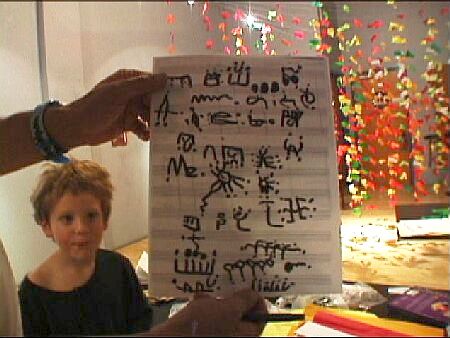 In 21st century America, the very notion of culture itself -- culture as something that arises from a community, in which all participate -- is endangered. In culture's place there is a pseudo-culture marketplace in which communities are replaced by isolated consumers who purchase entertainment products and services, and cultural professionals -- 'content providers' -- who sell to them.
In 21st century America, the very notion of culture itself -- culture as something that arises from a community, in which all participate -- is endangered. In culture's place there is a pseudo-culture marketplace in which communities are replaced by isolated consumers who purchase entertainment products and services, and cultural professionals -- 'content providers' -- who sell to them.
In this system musical artists tend to be categorized by their level of participation in this exchange. They are either good musicians, 'music industry professionals', highly skilled self-exploiting entrepreneurs who build careers manufacturing the musical products the marketplace demands -- or bad musicians, amateurs without the skills to make a living at it, hobbyists not unlike model train enthusiasts or collectors of unicorn figurines.
Neither of these categories capture the realities of artists’ lives. Not all lives are built around economic striving. In the context of our hyper-capitalist society, it's difficult for us to remember that for most of human history, most lives were not. The artists in my film remind us that there is another way to live: pursuing a passion directly, independent of its economic value. They exemplify an alternative political and social reality, a way of life largely outside of the dominant consumer culture of the USA.
None of the people I chose to study in the films on this disc are making a living with their music and every one of them are utterly committed to their work -- and have in fact built their lives around it. Rather than waiting for commercial or critical recognition, they have found and created opportunities to perform in their own neighborhoods and in the network of venues run by like-minded people around the world.
When asked what keeps him composing and performing in the face of little recognition, K. Atchley replies: "Passion . . . or pathology”, as well as the hope that “beauty will happen on my watch. " And while none of the featured musicians, as far as I know, are overtly religious, Plonsey calls being a musician "a high calling", Greenlief calls it "a sacred thing" and for Gino Robair it is "a spiritual matter that informs your whole life. "
Neither the term ‘amateur’ nor ‘professional’ capture what these people are doing.
Most of this I didn't understand before I began this film. As with many documentaries, the basic themes of the film only became clear well into the editing process. (How could you know what the point of a film is before you see what the footage has to say?) At first I thought I was simply stepping in to do a job I wished someone else had done, documenting a little-known musical scene with an interesting story. But it soon became clear that the film also touched upon a more basic question: what is the nature of a creative life, and how can one live it?
The film is also something of a love-letter to the Bay Area music community which I have enjoyed and participated in for over 25 years, a community that exemplifies many of the best attributes of a sound democratic culture. People are prized here for their uniqueness and individuality, but there is also an understanding that all meaningful creation arises from engagement, generosity and cooperation.
~~~ • ~~~
 But what of the music itself? While its practitioners form a strong creative community, there is plenty of disagreement among them about what it is they are actually creating. The music seems to exist in the cracks between different established genres/communities/practices, by turns appearing on the margins of jazz, or rock, or electronic dance music, as a form of contemporary Western (classical) art music, or as sound art -- a variant of the plastic arts and not properly music at all. Over the years the names used for this family of musics are most notable in their meaninglessness: New Music, Noise, Creative Music, Improvised Music, Avant Garde Music, Eclectic Music, Free Music, Sound Art. All essentially empty names.
But what of the music itself? While its practitioners form a strong creative community, there is plenty of disagreement among them about what it is they are actually creating. The music seems to exist in the cracks between different established genres/communities/practices, by turns appearing on the margins of jazz, or rock, or electronic dance music, as a form of contemporary Western (classical) art music, or as sound art -- a variant of the plastic arts and not properly music at all. Over the years the names used for this family of musics are most notable in their meaninglessness: New Music, Noise, Creative Music, Improvised Music, Avant Garde Music, Eclectic Music, Free Music, Sound Art. All essentially empty names.
This music seems to flee description; there is barely any handle by which outsiders can access it. Even where there is a vigorous scene as in the SF Bay Area, with dozens of performances at various venues every month, the concerts don't appear in any general media entertainment listings -- there is no category for them. The music is not just unpopular, it is aggressively unpopular, and when the Noisy People talk about community, they almost always are talking about a community of players. The audience, in the USA anyway, is nearly non-existent, largely consisting of players who don't happen to be playing that evening. The late composer and media researcher Rich Gold used to compare this situation to the archaic folk or tribal context in which the distinction between audience and performer has not solidified. In each performance it is as if a different member of the tribe were stepping into the center of the circle for the evening.
There is something mysterious and wonderful about the absolute refusal of this music to be pinned down. If it can’t be defined, it can’t be exploited, and perhaps this is the secret of its essential aloofness from the marketplace. If, as Debussy said, music is not in the notes but between the notes, then music is at its heart ephemeral, a light and infinitely protean thing. What then could be more musical than music that doesn't even have a name?
-- Tim Perkis
Feb 14 2007
Berkeley